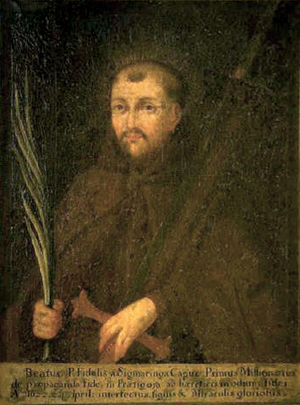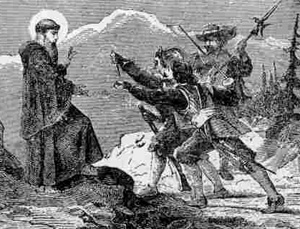 |
The Saint of the Day
St. Fidelis of Sigmaringen – April 24
Prof. Plinio Corrêa de Oliveira
Biographical selection:
Mark Rey was born in 1577 at Sigmaringen, Prussia. His father Johannes Rey was burgomaster of the city. He entered the University of Freiburg in Breisgau to study law and philosophy. After receiving his degree, he was chosen to be tutor to three young princes with whom he traveled in France and Italy.

The father of St. Fidelis was burgomaster of Sigmaringen, Prussia
|
In 1611, he returned to Freiburg to earn his doctorate in canon and civil law, and then began practice as a lawyer in Kolmar. Disappointed with the open fraud in the law courts and general corruption of society, he decided to abandon the world. He was ordained a priest the following year, and immediately after was received into the Capuchin Order at Freiburg at age 35. He took the name of Fidelis.
In notes that he left about his life during that period, he wrote: “From now on I want to live in complete poverty, chastity, and obedience amidst sufferings and persecutions and in austere penance and profound humility. I came from the womb of my mother with nothing, and with nothing I desire to return to the arms of my Savior.”
St. Fidelis was a remarkable orator. He preached in numerous German, Austrian and Swiss cities. From the beginning of his apostolic career, he struggled tirelessly to convert heretics; nor did he confine his efforts to the pulpit, but also used his pen. He wrote many pamphlets against Calvinism and Zwinglianism.
He was named Superior first at the Monasteries of Rheinfelden and Freiburg, and afterwards at Feldkirch, where he exerted a strong influence. Because of this, he was also appointed by the Papal Nuncio to reform monasteries of other Orders.

St. Fidelis of Sigmaringen
|
Since Calvinism was spreading over Switzerland, especially in the region of the Grisons, the Congregation for the Propagation of the Faith appointed the Capuchins to combat it there. Fr. Fidelis was chosen to be head of the mission.
“Shortly you will see me no longer,” he prophesied in a sermon in Feldkirch, “for I was called to shed my blood for the Faith.”
St. Fidelis labored indefatigably and with such success in the region that the heretics became alarmed and set themselves to inflame the people against him. They spread rumors that his mission was political rather than religious, and that he was preparing the way for the subjugation of the country by Austria.
In January 1622 on returning to the region of the Grisons, he was met everywhere with the cry: "Death to the Capuchins!" On April 24, 1622, being then at Grusch, he made his confession and afterwards celebrated Mass and preached. Then he set out for Sevis. When he arrived, he entered the church and began to preach, but was interrupted by a sudden tumult both within and without the church. Several Austrian soldiers who were guarding the doors of the church were killed by the attackers and Fidelis himself was struck.
Outside the church he was surrounded by a crowd led by Calvinist preachers who offered to save his life if he would apostatize. Fidelis replied: "I came to extirpate your heresy, not to embrace it." The Calvinists killed him with blows of swords.
Comments of Prof. Plinio:
It is interesting to note the action of this great orator, St. Fidelis of Sigmaringen. He was so successful in his sermons that the Holy See chose him to head the group of Capuchin preachers sent to the region infested by Calvinism, a branch of the Protestant heresy. The intention of the Holy See was to convert those who had been fooled by the heretics, and also to prevent Catholics from falling into the same trap.

St. Fidelis on St. Jacques at the chapel in Hazebrouck, Belgium, emphasizes his strong, virile spirit
|
Through his sermons, he had an enormous influence in the city of Feldkirch, the capital of an Austrian province in the Alps. There he had already strongly attacked the Protestants. He was designated, then, to enter Switzerland to continue the assault against the heretics. Before he left, he had a premonition revealing that he would suffer martyrdom there. As a supernatural, indomitable, energetic man, he did not step back because of that threat; on the contrary, he went forward facing death with a kind of joy. It is the attitude of a warrior.
To this tenacity he added another proof of valor: he infuriated the Calvinists. No one aggravates the enemy unless he counts victories over them. To prevent more of his remarkable successes, the Calvinists decided to murder him. They plotted his death and carried it out. He became a martyr.
St. Fidelis was, therefore, an audacious, strong, and vigorous missionary who willingly faced martyrdom. He presents to us an admirable example of fortitude. This is the spirit that should be seen in the notes he wrote about his life:
“From now on I want to live in complete poverty, chastity, and obedience amidst sufferings and persecutions and in austere penance and profound humility. I came from the womb of my mother with nothing, and with nothing I desire to return to the arms of my Savior.”

A Sulpician-style picture of St. Fidelis saturated with sentimentalism
|
Today this text would be interpreted by sentimental persons in a way that would provoke emotions and tears. Such interpretations follow the model of the 19th-century religious sentimentalism know as Sulpicianism, because its center was the Church of St. Sulpice in Paris. It produced Sulpician statues, Sulpician prayers, Sulpician ways of acting, and also Sulpician mentalities.
This invasion of sentimentalism inside the Church had a very harmful effect on the Catholic mentality. Acting in the tendencies of men, it strove to present the lives of almost all Saints from a sentimental perspective, which caused great damage to the militancy of the Catholic Church, her main characteristic.
One of the consequences of this sentimentalist approach was that it caused many serious persons to flee from piety, and perhaps even from the Church.
This text of St. Fidelis of Sigmaringen, however, should be interpreted according to the virile spirit that inspired all his actions. These words show that he had reached a high degree of wisdom, which led him to make an important decision in his life. One sees by the radical nature of his text that he was facing a dilemma: either to convert or to continue his prestigious life in the world and lose his soul. So, following the grace of wisdom that was inspiring him, he chose to become a Capuchin.
Now then, a Capuchin is the one who is oblivious to material goods, earthly prestige, and the kind of glory the world gives, which were probably attracting the young Mark Rey before he became a friar.

St. Fidelis faces his assassins: "I came to extirpate your heresy, not to embrace it"
|
Therefore, his choice was a virile act of will, an act dictated by reason: “To reach that supreme goal for which I was born, I will renounce all worldly pleasures and glories.” He realized that this was the way he was called to imitate Our Lord Jesus Christ.
What were the sufferings and the persecutions he endured because of this choice? Since he strongly attacked the enemies of the Church and left them no exit, they killed him. Therefore, he suffered the persecutions and trials of an indomitable warrior. And foreseeing the battle ahead, he wrote the lines quoted above.
He wrote them, therefore, without any sentimentalism. There was nothing syrupy in them, and the text should arouse a salutary admiration that is completely subordinate to reason. These words came from a man filled with wisdom and should produce in us a love for wisdom.
Let us ask St. Fidelis the Sigmaringen who strongly attacked the Revolution of his time to give us the love for wisdom that oriented his life in order to make us zealous counter-revolutionaries – as he was – for the glory and exaltation of Holy Mother Church.


  | | Prof. Plinio Corrêa de Oliveira | |
The Saint of the Day features highlights from the lives of saints based on comments made by the late Prof. Plinio Corrêa de Oliveira. Following the example of St. John Bosco who used to make similar talks for the boys of his College, each evening it was Prof. Plinio’s custom to make a short commentary on the lives of the next day’s saint in a meeting for youth in order to encourage them in the practice of virtue and love for the Catholic Church. TIA thought that its readers could profit from these valuable commentaries.
The texts of both the biographical data and the comments come from personal notes taken by Atila S. Guimarães from 1964 to 1995. Given the fact that the source is a personal notebook, it is possible that at times the biographic notes transcribed here will not rigorously follow the original text read by Prof. Plinio. The commentaries have also been adapted and translated for TIA’s site.
|
Saint of the Day | Home | Books | CDs | Search | Contact Us | Donate

© 2002- Tradition in Action, Inc. All Rights Reserved
|
 |

|